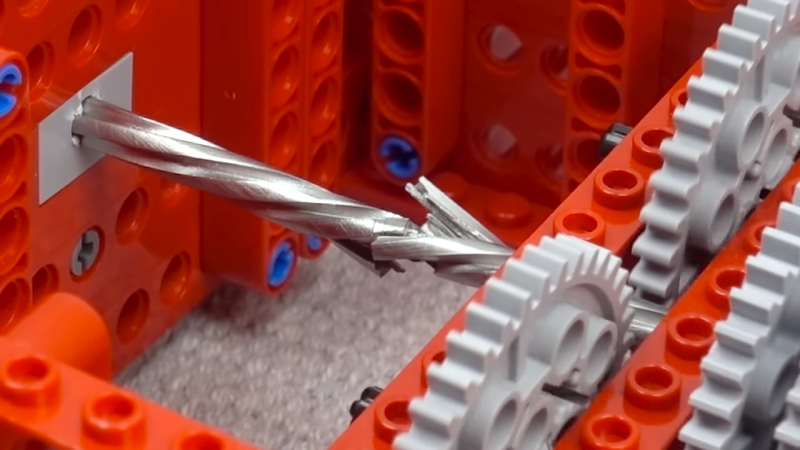Betteridge’s Law of Headlines holds that any headline ending in a question mark can be answered with a resounding “No”. But as the video below shows, a Lego machine that twists steel asunder is not only possible, it’s an object lesson in metal fatigue. Touché, [Betteridge].
In pitting plastic against metal, the [Brick Experiment Channel] relied on earlier work with a machine that was able to twist a stock plastic axle from the Technics line of parts like a limp noodle. The steel axle in the current work, an aftermarket part that’s apparently no longer available, would not prove such an easy target.
Even after beefing up the test stand with extra Technics struts placed to be loaded in tension, and with gears doubled up and reinforced with extra pins, the single motor was unable to overcome the strength of the axle. It took a second motor and a complicated gear train to begin to deform the axle, but the steel eventually proved too much for the plastic to withstand. Round Two was a bit of a cheat: the same rig with a fresh axle, but this time the motor rotation was constantly switched. The accumulated metal fatigue started as a small crack which grew until the axle was twisted in two.
The [Brick Experiment Channel] is a fun one to check out, and we’ve featured them before. Along with destructive projects like this one, they’ve also got fun builds like this Lego playing card launcher, a Technic drone, and a Lego submarine.
Thanks to [M&Mes] for the tip!
















“… but the steel eventually proved too much for the plastic to withstand.”
I’m confused. Should this be the other way around?
No, nevermind; I got it upon rereading.
The old white axles that came with these gears https://i.stack.imgur.com/Myh3j.jpg and the original lego motor would shatter easily when you made something like a low geared crawler and tried to push a chair with it or something.
probably made from a different, less-ductile plastic type or blend than the modern durable-ductile ABS. hard nylon, maybe?
Nylon is much tougher than ABS. I would think that if the gear were nylon, it would fail by deforming, not “shattering.” Maybe it was a poorer quality ABS? But I think the modern Lego gear shape is also much more mechanically sound, with shorter, stockier teeth.
They seemed more like nylon, by faint recollection. However, it was probably 5 years after they were factory fresh that I was putting real strain on them, maybe whatever it was, was not well stabilised from UV or something.
With a sharp blade you have stress concentrations factors at the blade tips that give rise to fatigue cracks. This isn’t really too shocking to those who have done a few fatigue calculations. Something to study is the concept of a fatigue limit. Aluminum basically does not have one, steel does. It is why aluminum parts that are subject to fatigue technically have a finite life, no matter the alternating stress, whereas steel if the alternating stress is low enough can have an infinite life. ‘Stress concentration’ factors would make a great haystack article….
Auto-correct got me ‘hackaday’
Most steel will ultimately yield too after something like 2e8-9 cycles – it’s just that nobody has the time to test that long. Steel also has no fatigue limit in a corrosive environment, which is technically anything involving moisture and air over a long time span. Some mechanisms may work 30 years without a problem and then just snap.
Other inputs on whether or not, or when, steel will break are the quality of the metal and temperature.
Tests were done in 1995 on steel recovered from the Titanic, and a piece of the hull plating saved by one of the riveters who worked on building the ship. IIRC the piece punched out to make a rivet hole was donated by the grandson of the riveter.
Standard sized “coupons” for a Charpy test were cut and notched from both samples, then chilled to -2C in an alcohol bath. When the pendulum hit the samples they both went PING as they snapped and flew across the room. There was zero bending deformation. The test proved that all those years of immersion had not altered the properties of the metal.
In contrast, a piece of modern hull steel just bends and goes THUD when hit with a Charpy pendulum, at room temp, -2C, and well below that.
The Titanic’s sisters, the Olympic and Britannic, never took any damage in sub-freezing water temperatures, so they’re no proof one way or the other of the quality of the Titanic’s plating.
But the facts don’t convince some Titanic “experts”. They just repeat over and over “Steel doesn’t shatter at -2C.” Well the metal used in the Titanic’s hull plates barely qualifies as “steel” and it definitely does shatter at -2C when hit with a sharp impact, like sideswiping an ice berg.
Steel in modern, well 80s and 90s cars isn’t all that great either. I quit trying to fix anything below -10C because bolts would snap off too easily. I think most of those had a super basic hardening process, like maybe roll forged steel plating would have back then.
I think you got something mixed up. Not having a fatigue limit doesn’t mean aluminium alloys can withstand unlimited stress amplitudes below its yield strength. The limit on steels means, under that limit the steel can withstand unlimited number of bends. Aluminium alloys on the other hand do not have this limit but will fail too.
The torque values don’t really apply due to friction, and you don’t need to twist the bar that much – just getting it to the point where it yields results in a fatigue failure within 10-100 cycles.
Just started to watch that channel. Very interesting and I like the format.